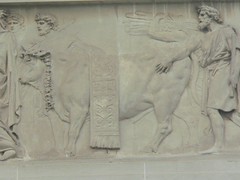Christmas – Pagan Origins
The Winter Solstice was traditionally celebrated on December 21 in the northern hemisphere. Well before the birth of Jesus, ancient peoples marked the Winter Solstice with celebrations and rejoicing that the coldest part of the year was behind them. From December 22, the days start to lengthen and the days gradually get warmer.
Christmas celebrations are, to some extent, the modern day equivalent of the Winter Solstice celebrations.
The actual birth of Jesus is widely believed not to have occurred in December. Nevertheless, the celebrations of Jesus’s birth occur on approximately the same day as the Winter Solstice. Christmas now serves as the mid-winter celebration for the northern hemisphere. Of course, in the southern hemisphere, Christmas falls in mid summer – at approximately the time of the Summer Solstice.
Saturnalia was also a celebration of the Winter Solstice that occurred in ancient pagan Rome. Saturnalia was celebrated in honor of the god of agriculture, named Saturn. During the time of Saturnalia, servants and peasants spend time with and celebrate the holiday with people of higher classes, which certainly did not occur throughout the rest of the year. The Saturnalia festival in itself could last as long as a week in Rome. During that time, people rejoiced all over Rome. The phrase ‘eat, drink, and be merry’ was played out to its fullest.
So celebrations at the time of the Winter Solstice were well established prior to the birth of Jesus. But what about some specific Christmas traditions with which we’re all familiar?
Do you think the Christmas tree originated as a Christian tradition? Well, think again – In Scandinavia during the Winter Solstice, men and their sons used
Pages: 1 2
